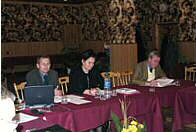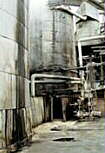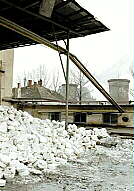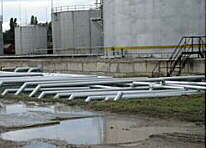 |
| Workshop in Odessa in October 2002 |
Since the year 2000, environmental projects in Central and Eastern Europe,
as well as those in the new independent countries, have been sponsored within
the framework of the newly created Consultancy and Support Programme of
Germany’s Environmental Ministry (BMU). The aim of the programme is
to introduce high-quality environmental standards in these countries, especially
in view of their possible EU-entry. It is integrated in the "Environment
for Europe” process and in the Environmental Action Programme for Central
and Eastern Europe which was agreed by the Ministers for Environment of
the UN/ECE.
Within this framework, the Federal Environmental Agency of Germany (UBA)
launched the project "Technology Transfer for Plant-Related Water Protection
in Romania, the Republic of Moldova and the Ukraine”.
Improving the safety level of industrial plants
One must not forget the significant potential harm to both humans and the
environment that may result from accidents in industrial plants dealing
with hazardous substances. Due to the rapid dispersal of contaminants in
large river catchment areas such as the Tisza and the Danube, the environmental
damage such incidents could cause would be felt beyond the national borders.
This has led the BMU/UBA to initiate the project with a view to improving
by special investigation methodologies the safety level of high-risk industrial
plants in terms of water pollution and by providing the basis for technology
transfer.
 |
| Leakages at a production plant |
Supported by the local environmental authorities, companies with a potentially
high environmental risk were investigated so that short, medium and long-term
measures to improve the current alarming situation could be proposed. The
specific findings from the different companies will be compiled and made
readily available to local experts conducting further investigations.
In 2000 and 2001, the project focussed mainly on activities in Romania (the
Somes/the Tisza) and the Republic of Moldova (the Prut), while current research
is concentrating on businesses in the river catchments of the Dnestrand
Tisza in the Ukraine.
Identification procedure
 |
| Storage of solids |
Based on the input from the different countries, a selection was made of
essential and relevant plants in the pharmaceutical, copper extraction,
pulp and paper industries as well plants for the treatment of water and
for the storage of dangerous substances. The analysis itself was based on
checklists that reflect the safety recommendations of the international
commissions for the protection of the Rhine (ICPR) and the Elbe (ICPE) rivers.
Each plant examination was followed by a catalogue containing proposals
for cost-effective, short, medium and long-term actions that significantly
raise safety level and reduce emergency response time.
The used checklists, the action plan and the questionnaire will continue
to be improved in terms of methodology in order to help the participating
countries develop inspection guidelines. The aim is to ensure that further
comprehensive and systematic investigations are conducted on plants that
involve a high risk of water pollution by relying on the gained experience
in order to reduce the overall industrial water pollution level, especially
pollution caused by accidents. In addition, the action catalogues that were
put together will serve as a basis for specific modernisation proposals
and for a transfer of technology.
Special workshops and product fairs have been designed to facilitate networking
between the approved companies and suppliers of safety and environmental
technology.
Results of the project
 |
| Unloading station for water hazardous fluids from railroad tank cars |
In addition to bringing to the examined companies and the involved local
authorities specific advantages in terms of knowledge and technology transfer,
the results of the project should reach and benefit communities worldwide
by being continuously communicated through publications and in international
workshops and seminars. So far, for instance, the developed checklist concept
has been recommended by the International Commission for the Protection
of the Danube River (ICPD) for application in all countries bordering on
the Danube. Similarly, the developed checklist method has been acknowledged
as a "living document” by the UN/ECE joint expert group and recommended
for application in all UN/ECE countries. When Project results were presented
to the Black Sea Commission, they aroused large interest among the Black
Sea countries. In the project currently under way in part of the Ukraine,
it is possible to use the results obtained during the first phase of the
Project implementation in Romania and Moldova.
 |
| Single wall pipe subway with a lack of knock-down protection |
Further similar pilot projects shall be executed in the future to ensure an appropriate level of training for local authorities. Corresponding proposals have been worked out for the contracting state conference of the UN/ECE industry and water conventions to be held at end of 2002 or 2003. Besides the systematic development of the checklist concept, cross-border emergency communication is also about to be improved and tested.